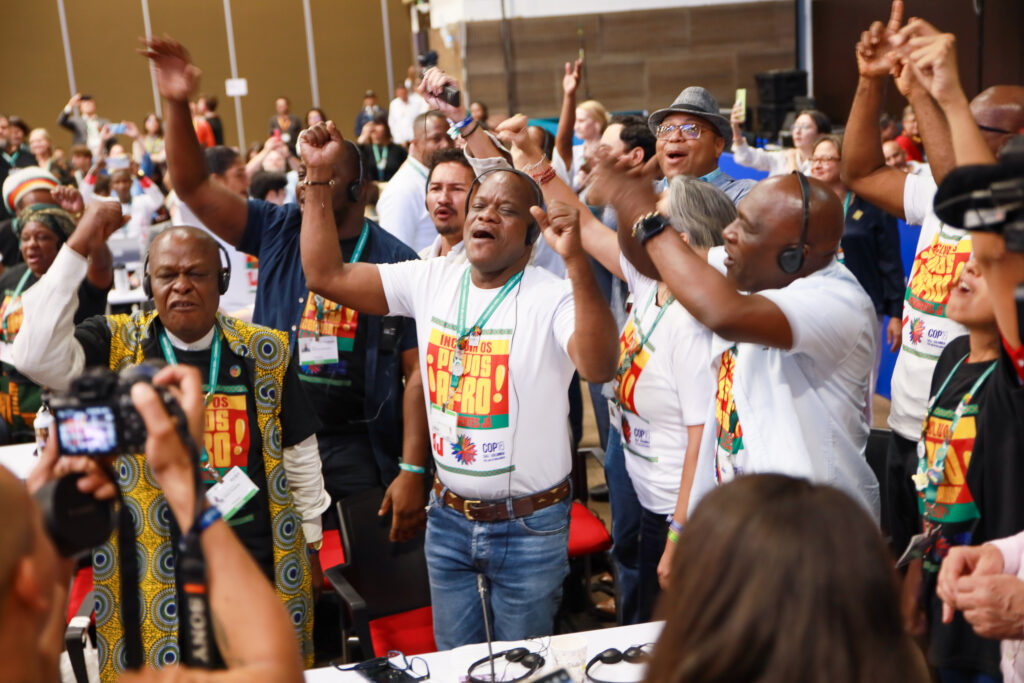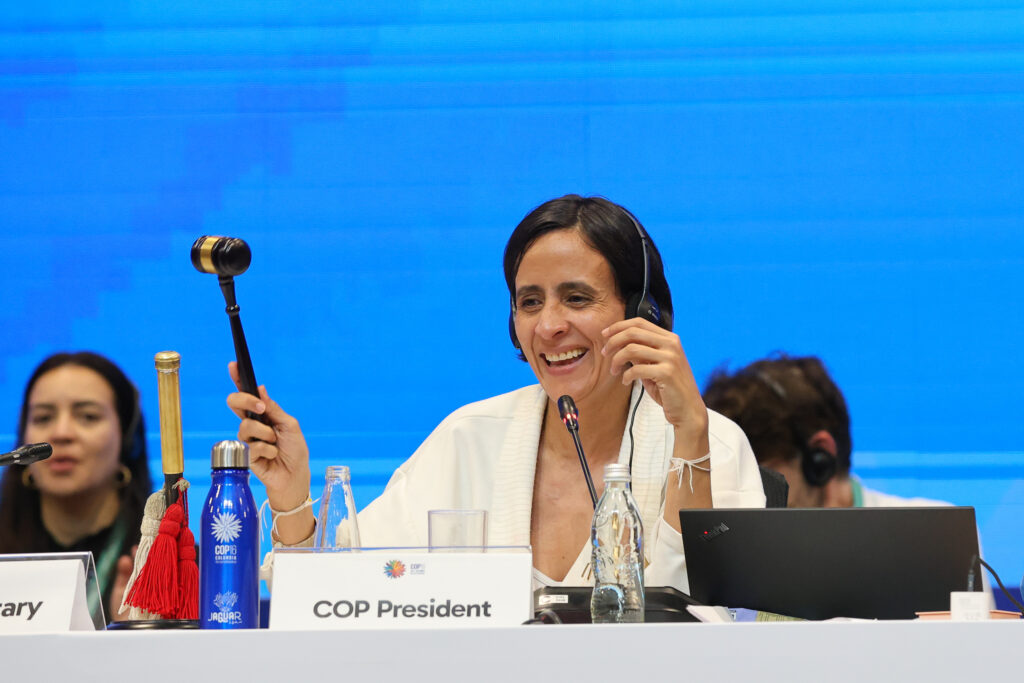
The 16th meeting of the Conference of the Parties to the Convention on Biological Diversity (COP 16) was suspended on the morning of Nov. 2 but not before countries agreed on an expanded role of Indigenous Peoples and local communities in saving biodiversity and a groundbreaking agreement on the operationalization of a new global mechanism to share benefits from digital genetic information.
The strong results, built on a spirit of compromise, and dialogue, demonstrate that multilateralism can still achieve results in a fractious time. After roughly 12 hours of meeting in the Plenary session, at roughly 9 am COP 16 lost quorum and was suspended before approval of a few last items.
It will resume at a later date and venue to complete the agenda.
The results at COP 16 are important strides towards the achievement of the 23 targets for 2030 laid out in the Kunming-Montreal Global Biodiversity Framework (KMGBF), adopted at the previous meeting of the Convention’s 196 Parties in Montreal in 2022.
With billions of people depending on nature’s contributions, threats to biodiversity intensifying, and financial resources in short supply, the stakes at COP 16 were high.

Among the notable achievements after 12 days of negotiations:
“Cali Fund” is Launched: Sharing the Benefits from Digital Genetic Information
Having agreed at COP 15 to establish a multilateral mechanism, including a global fund, to share the benefits from the uses of digital sequence information on genetic resources (DSI) more fairly and equitably, delegates at COP 16 advanced its operationalization – a historic decision of global importance.
This complex decision addresses how pharmaceutical, biotechnology, animal and plant breeding and other industries benefiting from DSI should share those benefits with developing countries and Indigenous Peoples and local communities.
Under the agreed guidelines, large companies and other major entities benefiting commercially from DSI uses should contribute to “the Cali Fund,” based on a percentage of their profits or revenues. The model targets larger companies most reliant on DSI and exempts academic, public research institutions and other entities using DSI but not directly benefiting.
Developing world countries will benefit from a large part of this fund, with allocations to support implementation of the KMGBF, according to the priorities of those governments.
At least half of the funding is expected to support the self-identified needs of Indigenous peoples and local communities, including women and youth within those communities, through government or by direct payments through institutions identified by Indigenous peoples and local communities. Some funds may support capacity building and technology transfer.
Strong monitoring and reporting will ensure industries see the impact of their contributions in a transparent and open way, and regular reviews will build the mechanism’s efficiency and efficacy over time.
This agreement marks a precedent for benefit-sharing in biodiversity conservation with a fund designed to return some of the proceeds from the use of biodiversity to protect and restore nature where help is needed most.
Strengthening the Role of Indigenous Peoples and Local Communities in Biodiversity Efforts
In a landmark decision at COP 16, Parties adopted a new Programme of Work on Article 8(j) and other provisions of the Convention related to indigenous peoples and local communities. This transformative programme sets out specific tasks to ensure the meaningful contribution of Indigenous peoples and local communities towards the three objectives of the Convention ((a) the conservation of biological diversity, b) the sustainable use of biological diversity, and c) the fair and equitable sharing of benefits), as well as the implementation of the KMGBF. Through this Programme, rights, contributions and traditional knowledge of indigenous peoples and local communities are further embedded in the global agenda.
Parties also agreed to establish a new permanent subsidiary body on Article 8j and other Provisions, with its modus operandi to be developed over the next two years. The new Subsidiary Body is expected to elevate issues related to the implementation of Article 8j and enhance the engagement and participation of indigenous peoples and local communities in all convention processes.
A further decision was taken to recognize the role of people of African descent, comprising collectives embodying traditional lifestyles, in implementing the Convention and in the conservation and sustainable use of biodiversity.



Funding Biodiversity: A Strategy for Resource Mobilization
Parties at COP 16 will resume discussions later to approve a new “Strategy for Resource Mobilization” to help secure $200 billion annually by 2030 from all sources to support biodiversity initiatives worldwide, representing one of the KMGBF’s goals. Another is the redirection by 2030 of $500 billion per year in subsidies that harm biodiversity.
Parties will also look at the possible creation of a new dedicated global financing instrument for biodiversity to receive, disburse, mobilize and articulate funding needs.
To date the Convention has been able to count on resources mobilized to support the goals and targets of the GBF through a variety of bilateral arrangements, private, and philanthropic sources, as well as dedicated funds such as:
- The Global Biodiversity Framework Fund (GBFF), agreed at COP 15 in 2022 and established in less than a year by the Global Environment Facility (GEF). The fund accepts contributions from governments, the private sector, and philanthropies, and finances high-impact projects in developing regions, with emphasis on supporting countries with fragile ecosystems, such as small island states and economies in transition. To date, 11 donor countries as well as the Government of Quebec have pledged nearly US $400 million to the GBF Fund, with US $163 million pledged during COP 16.
- The Kunming Biodiversity Fund (KBF), was launched at COP 16 with a US $200 million contribution from the Government of China. The KBF supports accelerated action to deliver the 2030 Agenda and SDG targets and 2050 goals of the Kunming-Montréal Global Biodiversity Framework, particularly in developing countries.
COP 16 also considered an evaluation of the effectiveness of the GEF, which serves as the financial mechanism of the Convention. The evaluation noted that the GEF has made significant progress in its role in resource mobilization and in supporting the implementation of activities that achieve the objectives of the CBD. The report of the GEF to COP 16 noted that during the first two years of its current funding cycle (GEF-8), the GEF approved 2.42 billion in direct support to the KMGBF.
Implementing and Monitoring the KMGBF
Delegates also took stock of progress in implementing the KMGBF since its creation in 2022. Some 119 countries, representing the majority of CBD’s 196 Parties, submitted national biodiversity targets – policy measures and actions to help reach the 23 KMGBF targets.
Additionally, to date, 44 countries have submitted National Biodiversity Strategy and Action Plans as the policy document which will support the implementation of these national targets. COP 16 acknowledged the remarkable progress made within two years and highlighted the need to accelerate action.
Synthetic Biology
Synthetic biology was a prominent topic at COP 16, with an eye toward its potential benefits while considering the risks. To address inequity in the participation of developing countries in the synthetic biology field, the decision introduces a new thematic action plan to help address the capacity-building, technology transfer and knowledge-sharing needs of Parties, Indigenous Peoples and Local Communities. By helping countries assess and apply synthetic biology technologies, COP 16 aims to foster innovation while safeguarding biodiversity.
An expert group will guide the identification of synthetic biology’s potential benefits and review the potential impacts of recent technological developments – a unique opportunity to explore synthetic biology in relation to the CBD’s three fundamental objectives and in implementing the KMGBF.
COP 16’s decision on invasive alien species addresses one of the top five direct drivers of biodiversity loss, highlighting the need for international cooperation, capacity-building, and technical support for developing countries. It proposes guidelines for managing invasive alien species, touching on issues such as e-commerce, multicriteria analysis methodologies and others.
New databases, improved cross-border trade regulations, and enhanced coordination with e-commerce platforms aim to address gaps in managing invasive species risks and align with the goals of KMGBF, where cross-sectoral and collaborative approaches are central to biodiversity protection.

Ecologically or Biologically Significant Marine Areas (EBSAs)
COP 16 agreed on a new and evolved process to identify ecologically or biologically significant marine areas (EBSAs). Under the CBD, work on EBSAs, which identifies the most critical and vulnerable parts of the ocean, began in 2010 and became a central area of ocean-related work. Continued development of the programme was stymied for more than 8 years due to legal and political concerns. COP 16 gave new life to this process, agreeing on new mechanisms to identify new EBSAs and update existing ones, ensuring that the cataloguing of information in these areas can support planning and management with the most advanced science and knowledge available.
This comes at a time when EBSAs can play an important role in marine biodiversity protection, with major steps being taken to implement the 30×30 protected areas target and to prepare for the future implementation of the new agreement for marine biodiversity beyond national jurisdiction..
Sustainable Wildlife Management and Plant Conservation
Among the most crucial areas of discussion was the protection of wild species. A decision on sustainable wildlife management underscores the necessity of monitoring, capacity-building, and the inclusive participation of indigenous peoples, local communities, and women. To this end, the decision calls for the cooperation of international bodies like CITES and FAO to be implemented. The framework encourages research on how wildlife use, biodiversity loss, and zoonotic diseases are interconnected, a vital area for a world increasingly aware of the public health implications of biodiversity loss.
Additionally, COP 16 saw a commitment to align plant conservation efforts with the KMGBF monitoring framework. This includes updating the Global Strategy for Plant Conservation with specific indicators and a standardized reporting template, ensuring that progress in plant protection is measurable and consistent with global biodiversity targets.
Biodiversity and health
At COP 16, CBD Parties approved a Global Action Plan on Biodiversity and Health designed to help curb the emergence of zoonotic diseases, prevent non-communicable diseases, and promote sustainable ecosystems. The strategy embraces a holistic “One Health” approach that recognizes the health of ecosystems, animals, and humans as interconnected.
Recognizing that biodiversity loss and poor health often share common drivers—such as deforestation, pollution, and climate change—the Plan emphasizes the urgency of tackling these threats to benefit both ecosystems and humans.
The strategy underlines the need for education and promoting understanding of the connections between biodiversity and health, and the need to strengthen policies that promote sustainable ecosystems, support traditional medicine, and reduce habitat destruction. Special attention is accorded to vulnerable populations, including Indigenous peoples, who depend on local biodiversity for food, medicine, and cultural identity, as well as youth, seen as vital contributors to conservation and health initiatives.
At the heart of the plan is a collaborative framework that brings together health professionals, conservationists, and policymakers. The COP decision invites nations to designate national focal points for biodiversity and health, and to develop policies reflecting these interconnections, integrating biodiversity-health considerations in policies across the range of sectors from agriculture to urban planning.
Parties further called for close cooperation with international organizations, including the World Health Organization, to develop monitoring tools and metrics for assessing the progress of biodiversity-health initiatives.
Risk assessment
In Cali, Parties to the Cartagena Protocol on Biosafety welcomed new, voluntary guidance on assessing the risks posed by living modified organisms (LMOs) containing engineered gene drives, a milestone in international biosafety management aiming to bolster the scientific rigour and transparency of risk assessment procedures in the Protocol.
Engineered gene drives can propagate genetic modifications rapidly through wild populations and the move to strengthen protocols comes amid increased debate over genetic engineering, particularly for applications for pest control, disease control, and agriculture. The new guidance prioritizes scientific transparency and accuracy in risk assessments, an essential step toward unified safety standards for managing LMOs worldwide.

The new guidance materials bring together the best available scientific resources and guidance materials available for environmental risk assessment, while also emphasizing the precautionary approach.
The voluntary nature of these guidelines allows individual countries to tailor assessments to national contexts, considering ecological variables unique to their environments. This flexibility is crucial in regions with diverse ecosystems and will help regulators make informed decisions, taking into account both the benefits and risks of LMOs with gene drives.
“Over the last weeks, we have seen the largest, whole-of-society mobilization for biodiversity unfold in Cali, triggering interest from around the globe. We have seen Indigenous Peoples and local communities, civil society, businesses and financial institutions, sub-national governments, cities and local authorities, women and youth present remarkable initiatives and action.
And through it all, this COP delivered a seminal message: the time has come to make peace with nature.
“From Cali, this UN Biodiversity Conference sent a powerful call to action. It has never been clearer that the implementation of the Kunming-Montreal Global Biodiversity Framework and the Paris Agreement in a synergistic fashion will make peace with nature within reach,” said Astrid Schomaker, Executive Secretary, Convention on Biological Diversity
“We arrived in Cali with a heavy agenda of work, and thanks to the determination of countries and the energy from this ‘People’s COP’, we’ve made good progress. COP16 has delivered important commitments on the interconnections on nature and climate, biodiversity and health and Ecologically or Biologically Significant Marine Areas (EBSAs). The new agreement on Article 8J is a critical step forward and commits us to embed the knowledge and role of Indigenous Peoples and local custodians across our work to deliver the Global Biodiversity Framework. Another big win is the new mechanism and fund for fair and equitable benefit-sharing from Digital Sequencing Information of genetic resources which will ensure that those who profit from biodiversity give back to nature, countries and communities. Of course, we would have liked to achieve more on resource mobilization and advances in the monitoring framework, but we will not slow down the pace of work. 2030 is rapidly approaching and action cannot wait,” Inger Andersen, Under-Secretary-General of the United Nations and Executive Director of the United Nations Environment Programme said.








